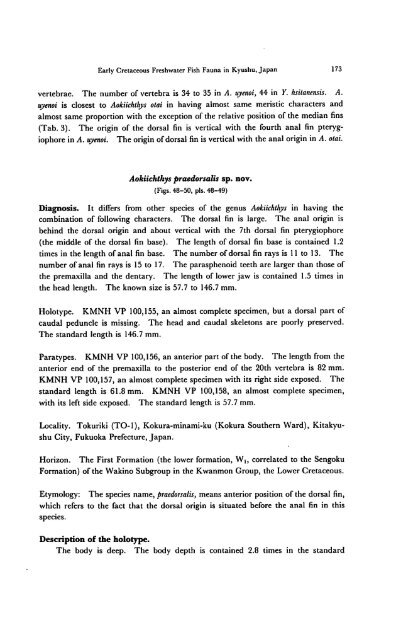Early Cretaceous Freshwater Fish Fauna in Kyushu, Japan
Early Cretaceous Freshwater Fish Fauna in Kyushu, Japan
Early Cretaceous Freshwater Fish Fauna in Kyushu, Japan
Create successful ePaper yourself
Turn your PDF publications into a flip-book with our unique Google optimized e-Paper software.
<strong>Early</strong><strong>Cretaceous</strong> <strong>Freshwater</strong> <strong>Fish</strong> <strong>Fauna</strong> <strong>in</strong> <strong>Kyushu</strong>, <strong>Japan</strong> 173<br />
vertebrae. The number of vertebra is 34 to 35 <strong>in</strong> A. uyenoi, 44 <strong>in</strong> Y. hsitanensis. A.<br />
uyenoi is closest to Aokiichthys otai <strong>in</strong> hav<strong>in</strong>g almost same meristic characters and<br />
almost same proportion with the exception of the relative position of the median f<strong>in</strong>s<br />
(Tab. 3). The orig<strong>in</strong> of the dorsal f<strong>in</strong> is vertical with the fourth anal f<strong>in</strong> pteryg<br />
iophore<strong>in</strong> A. uyenoi. The orig<strong>in</strong>ofdorsal f<strong>in</strong> is vertical with the anal orig<strong>in</strong> <strong>in</strong> A. otai.<br />
Aokiichthys praedorsalis sp. nov.<br />
(Figs. 48-50, pis. 48-49)<br />
Diagnosis. It differs from other species of the genus Aokiichthys <strong>in</strong> hav<strong>in</strong>g the<br />
comb<strong>in</strong>ation of follow<strong>in</strong>g characters. The dorsal f<strong>in</strong> is large. The anal orig<strong>in</strong> is<br />
beh<strong>in</strong>d the dorsal orig<strong>in</strong> and about vertical with the 7th dorsal f<strong>in</strong> pterygiophore<br />
(the middle of the dorsal f<strong>in</strong> base). The length of dorsal f<strong>in</strong> base is conta<strong>in</strong>ed 1.2<br />
times <strong>in</strong> the length of anal f<strong>in</strong> base. The number of dorsal f<strong>in</strong> rays is 11 to 13. The<br />
number of anal f<strong>in</strong> rays is 15 to 17. The parasphenoid teeth are larger than those of<br />
the premaxilla and the dentary. The length of lower jaw is conta<strong>in</strong>ed 1.5 times <strong>in</strong><br />
the head length. The known size is 57.7 to 146.7 mm.<br />
Holotype. KMNH VP 100,155, an almost complete specimen, but a dorsal part of<br />
caudal peduncle is miss<strong>in</strong>g. The head and caudal skeletons are poorly preserved.<br />
The standard length is 146.7 mm.<br />
Paratypes. KMNH VP 100,156, an anterior part of the body. The length from the<br />
anterior end of the premaxilla to the posterior end of the 20th vertebra is 82 mm.<br />
KMNH VP 100,157, an almost complete specimen with its right side exposed. The<br />
standard length is 61.8 mm. KMNH VP 100,158, an almost complete specimen,<br />
with its left side exposed. The standard length is 57.7 mm.<br />
Locality. Tokuriki (TO-1), Kokura-m<strong>in</strong>ami-ku (Kokura Southern Ward), Kitakyu<br />
shu City, Fukuoka Prefecture, <strong>Japan</strong>.<br />
Horizon. The First Formation (the lower formation, Wj, correlated to the Sengoku<br />
Formation) of the Wak<strong>in</strong>o Subgroup <strong>in</strong> the Kwanmon Group, the Lower <strong>Cretaceous</strong>.<br />
Etymology: The species name, praedorsalis, means anterior position of the dorsal f<strong>in</strong>,<br />
which refers to the fact that the dorsal orig<strong>in</strong> is situated before the anal f<strong>in</strong> <strong>in</strong> this<br />
species.<br />
Description of the holotype.<br />
The body is deep. The body depth is conta<strong>in</strong>ed 2.8 times <strong>in</strong> the standard

















